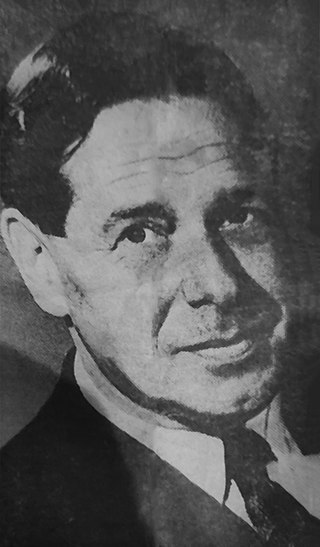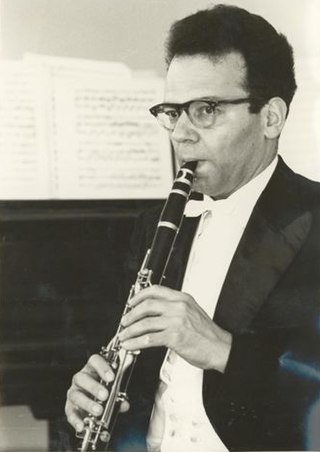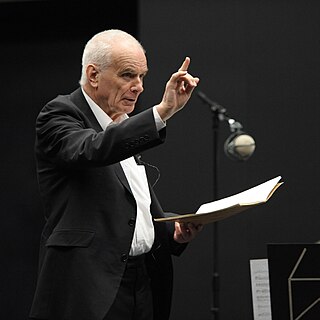Related Research Articles

Isang Yun, also spelled Yun I-sang, was a Korean-born composer who made his later career in West Germany.

Grażyna Bacewicz Biernacka was a Polish composer and violinist. She is the second Polish female composer to have achieved national and international recognition, the first being Maria Szymanowska in the early 19th century.
Gordon Percival Septimus Jacob CBE was an English composer and teacher. He was a professor at the Royal College of Music in London from 1924 until his retirement in 1966, and published four books and many articles about music. As a composer he was prolific: the list of his works totals more than 700, mostly compositions of his own, but a substantial minority of orchestrations and arrangements of other composers' works. Those whose music he orchestrated range from William Byrd to Edward Elgar to Noël Coward.
Arnold Atkinson Cooke was a British composer.

Robin Greville Holloway is an English composer, academic and writer.

Arthur Leslie Benjamin was an Australian composer, pianist, conductor and teacher. He is best known as the composer of Jamaican Rumba (1938) and of the Storm Clouds Cantata, featured in both versions of the Alfred Hitchcock film The Man who Knew Too Much, in 1934 and 1956.
Jindřich Feld was a Czech composer of classical music.
York Höller is a German composer and professor of composition at the Hochschule für Musik Köln.
Frederick John Thurston was an English clarinettist.
Stefans Grové was a South African composer. Before his death the following assessment was made of him: "He is regarded by many as Africa's greatest living composer, possesses one of the most distinctive compositional voices of our time".
Roger Steptoe is an English composer and pianist. He studied music at the University of Reading as an undergraduate and then at the Royal Academy of Music, London, from 1974 to 1977 as a post-graduate student. There he studied composition with Alan Bush and piano accompaniment with Geoffrey Pratley.

Yona Ettlinger was a clarinetist who played and taught in Israel, France and England. Ettlinger is considered a prominent classical clarinetist of his generation, and one of Israel's notable instrumentalists. His musicianship and unique sound influenced the art of clarinet playing in Israel and Europe in the second half of the 20th century. Many clarinet soloists and orchestra players of different countries were among his students.
Freda Swain was a British composer, pianist and music educator.
Mary Lucas, sometimes referred to as Mary Anderson Lucas, was an English composer and pianist.
Juraj Filas was a Slovak composer. His work included more than 100 compositions: symphonies, cantatas, numerous compositions for chamber ensemble, as well as the prize-winning TV opera Memento Mori; a concerto grosso Copernicus; the opera Jane Eyre (2010); The Wisdom of the Wise Man, a cantata for choir, cello and organ; The Song of Solomon, a cantata for soli, choir and orchestra; and the requiem Oratio Spei, which was dedicated to the victims of terrorism.
Malcolm Lipkin was an English composer.

The Symphony No. 5 was composed by Peter Maxwell Davies in 1994 on commission from the Philharmonia Orchestra, who gave the world premiere under the composer's direction at a BBC Promenade concert on 9 August 1994 at the Royal Albert Hall in London.
Herbert Howells completed his sonata for oboe and piano in 1942. Rejected by its planned dedicatee Léon Goossens, the composition was suppressed and not performed in public until after the composers death in 1983.
References
Notes
- ↑ In 1975, the composer began work on a Flute sonata that was unfinished at the time of his death.
- ↑ Sorrels 2018 , p. 9
- ↑ Burns 2004 , p. 3
- ↑ Quinn 2005
- ↑ Huss 2013 , p. 153
- ↑ Huss 2013 , pp. 153–154
- ↑ Anon. 1999 , p. 2
- ↑ Razey 2018 , p. 53
Sources
- Anon. (1999). Music for Oboe (PDF) (CD). Hyperion Records. CDH55008.
- Burns, Andrew (2004). Howells: Rhapsodic Quintet/Violin Sonata No. 3 (CD). Naxos Records. 8.557188.
- Ferguson, Howard; Matthew-Walker, Robert (1997). English Music for Clarinet (PDF) (CD). Hyperion Records. CDD22027.
- Huss, Fabian (2013). "Chapter 9: Style and Structure in the Oboe Sonata and Clarinet Sonata". In Cooke, Phillip A.; Maw, David (eds.). The Music of Herbert Howells. Boydell & Brewer Ltd. ISBN 978-1-84383-8791.
- Quinn, John (2005). "Review: Howell - Rhapsodic Quintet/Violin Sonata No. 3/Clarinet Sonata/Harp Prelude". Musicweb International. Retrieved 1 March 2020.
- Razey, Aileen Maree (2018). The Inspiration Behind Compositions for Clarinetist Frederick Thurston (PDF) (D. Mus.). University of North Texas . Retrieved 4 March 2020.
- Sorrels, Keith (26 October 2018). Thematic continuity and melodic recycling in Herbert Howells's sonata for oboe and piano (D. Mus.). Indiana University . Retrieved 1 March 2020.